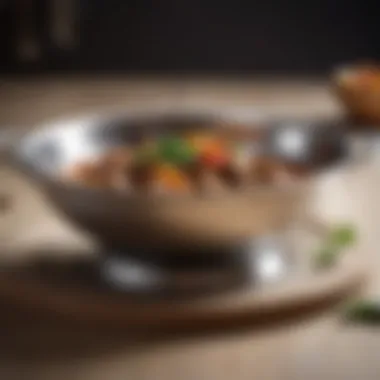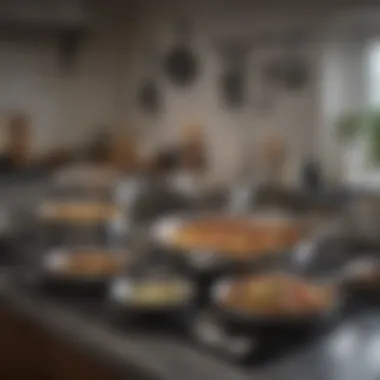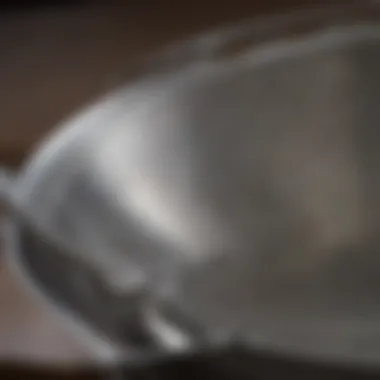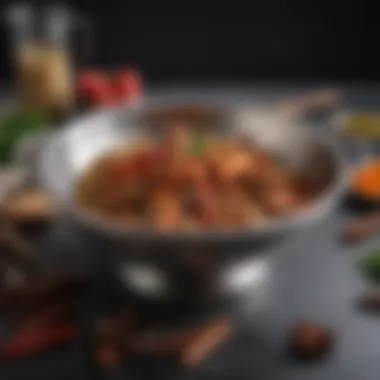The Best Stainless Steel Kadai: A Comprehensive Evaluation


Intro
In the realm of culinary arts, the choice of cookware holds significant importance. Especially for diverse cooking experiences, a stainless steel kadai emerges as a pivotal tool. Its role in preparing various dishes, from deep-fried snacks to savory curries, cannot be overstated. This article aims to evaluate the best stainless steel kadai available in the market, offering insights into their characteristics, advantages, and maintenance techniques.
Understanding the material properties of stainless steel can help one choose the right kadai. Stainless steel is renowned for its durability, resistance to rust, and non-reactivity with food. This makes it an ideal option for cooking, ensuring your dishes retain their true flavors without any metallic taste.
With an array of products available, selecting the right kadai involves considering factors such as size, weight, and compatibility with cooking surfaces. From novice cooks to seasoned chefs, everyone strives for optimal cooking results. This guide not only showcases top-rated stainless steel kadai, but also offers maintenance tips to prolong their lifespan and improve cooking outcomes.
Let’s delve into the detailed characteristics, essential factors for choosing, and recommended products that can significantly enhance your culinary experience.
Preface to Stainless Steel Kadai
Stainless steel kadai plays an essential role in culinary practices, particularly in South Asian cuisine. This cooking vessel is appreciated for its unique features and versatility. Understanding how a stainless steel kadai operates can alter the effectiveness of cooking and food preparation. The materials used, along with design elements, greatly contribute to its functionality. Thus, it becomes imperative to delve into the details surrounding these characteristics and their implications.
A stainless steel kadai serves as an all-purpose pot, used for deep frying, sautéing, and cooking various dishes. Its design allows for even heat distribution, which is necessary for optimal cooking results. Moreover, stainless steel is prized for its non-reactive properties, which enable it to retain flavors without leaching into food. As we evaluate the best options available, we will explore how these features benefit culinary enthusiasts and everyday cooks alike.
Definition and Purpose
A kadai is defined as a round, deep cooking vessel traditionally used in Indian and Pakistani kitchens. Designed with high sides and a wide base, it is ideal for cooking at high temperatures. The purpose of a stainless steel kadai extends beyond mere cooking; it is about enhancing culinary experiences.
Stainless steel, particularly, provides durability and resistance to corrosion. This makes it a suitable choice for cooking various types of dishes, whether they are rich curries or crispy fried snacks. It is not just about cooking; it also aids in achieving the right textures and flavors.
Historical Context of Kadai Usage
The kadai has a long-standing history in culinary traditions across South Asia. Originating from the Indian subcontinent, it has evolved through generations. Traditionally, kadais were made from cast iron, providing excellent heat retention. However, as cooking technology evolved, stainless steel became a preferred option due to its ease of maintenance.
In modern kitchens, the use of a stainless steel kadai reflects a balance of tradition and innovation. It caters to nutritional needs as well, allowing for health-conscious cooking without compromising taste. Historically, the kadai was essential for community and family gatherings, emphasizing its cultural significance. Today, it remains a vital tool, bridging past and present in sustainable cooking practices.
Characteristics of Stainless Steel Cookware
Understanding the characteristics of stainless steel cookware is paramount for anyone looking to enhance their cooking experience. These features not only dictate how well the cookware performs but also its durability and ease of use in the kitchen. For culinary enthusiasts, knowing what to look for can significantly impact the quality of the dishes they prepare. This section delves into specific elements of stainless steel cookware, pinpointing its material properties, advantages compared to other cookware types, and factors influencing its performance.
Material Properties
Stainless steel is an alloy primarily composed of iron, carbon, and a minimum of 10.5% chromium. The chromium content is crucial as it forms a protective layer of chromium oxide that keeps the metal from rusting and tarnishing. One of the standout properties of stainless steel is its non-reactivity. This means it does not alter the taste or nutritional value of food, which is ideal for preparing various dishes. Additionally, stainless steel is known for its high resistance to corrosion and staining, making it suitable for heavy and regular use in kitchens.
Moreover, the thermal conductivity of stainless steel varies depending on the specific alloy used. Many high-quality stainless steel kadais feature an aluminum or copper core sandwiched between layers of stainless steel. This construction enhances heat distribution, promoting even cooking and reducing the risk of hot spots that can burn food.
Advantages Over Other Materials
Stainless steel cookware enjoys several advantages over other materials such as non-stick, cast iron, and aluminum. One of the primary benefits is its durability. Unlike non-stick coatings that may wear off over time, a well-maintained stainless steel kadai can last a lifetime. This makes it a cost-effective choice in the long run.
Some advantages include:
- Non-reactive nature: Ideal for cooking acidic foods without affecting flavor.
- High heat tolerance: Can withstand high cooking temperatures, which is essential for searing and frying.
- Versatility: Suitable for a variety of cooking methods, including frying, sautéing, and even baking.
- Easy maintenance: Typically dishwasher-safe and resistant to scratches, making it simpler to clean compared to other options.
Factors Affecting Performance
The performance of stainless steel cookware can vary based on several factors. Understanding these elements helps in selecting the right kadai for specific cooking tasks.
- Base thickness: A thicker base usually implies better heat retention and even distribution. This minimizes the chances of burning and allows for better control when frying or simmering.
- Quality of the alloy: Higher-grade stainless steel, often characterized by a higher chromium and nickel content, provides better resistance to wear and corrosion. It also enhances flavor preservation.
- Design features: Aspects like handle strength and comfort can affect cooking efficiency. Well-designed handles can offer better grip, providing safety while maneuvering hot cookware.


Key Considerations When Choosing a Kadai
Selecting the right kadai is central to achieving culinary success. The characteristics of a kadai can significantly affect cooking outcomes, durability, and user experience. Understanding key considerations allows the buyers to make informed choices. Factors such as size, base thickness, handle design, and lid types play pivotal roles in the overall performance of a kadai. Here’s a closer look at these essential elements.
Size and Capacity
The size of a kadai is among the most crucial factors to consider. Choosing a size that fits your cooking needs is vital. A kadai that is too small can lead to overcrowding, resulting in uneven cooking. Conversely, an overly large kadai can waste energy and lead to longer cooking times. When evaluating size, consider the number of servings you typically prepare. A 3-liter kadai may suffice for a small family, but larger households might need a 5-liter or bigger one.
Furthermore, the dimensions also impact storage. Ensure the kadai fits comfortably in your kitchen cabinets. An adjustable cooking capacity opens opportunities to create various dishes, enhancing versatility in the kitchen.
Base Thickness and Heat Distribution
Base thickness is essential in determining how evenly heat distributes throughout the kadai. A thicker base usually means better heat retention and distribution, leading to more consistent cooking results. Thin bases can create hot spots, resulting in burnt food in certain areas while other parts may remain undercooked. For optimal performance, look for a kadai with a base thickness of at least 3 mm.
Materials play a role too. Stainless steel conducts heat effectively, but layered bases featuring copper or aluminum enhance thermal properties. This ensures that heat spreads quickly and evenly, reducing cooking time and improving the quality of food.
Handle Design and Comfort
Comfort while handling the kadai is often overlooked but is crucial in safely maneuvering hot cookware. The design of the handle should allow for a firm grip without excessive strain. Look for kadais that feature silicone or plastic grips, which offer insulation against heat and improve comfort.
Additionally, the placement and length of the handle are significant as well. A well-designed handle keeps balance while pouring or stirring, minimizing the risk of drops or spills. For users with limited upper body strength, consider lighter models or those with double handles for better control.
Lid Types and Their Benefits
Lids on kadais are not only for covering but also for retaining heat and moisture during cooking. When evaluating lid types, pay attention to material and design. A tempered glass lid provides visibility while cooking, allowing you to monitor progress without lifting the lid.
Moreover, a tight-fitting lid enhances efficiency by trapping steam, which can be particularly beneficial for dishes that require simmering or braising. Consider a kadai that includes a helper or steam vent, which promotes better pressure regulation.
In summary, each of these considerations serves specific functions that can enhance the cooking experience. When combined, they lead to a more efficient, enjoyable, and successful culinary process.
Analysis of the Best Stainless Steel Kadai
Understanding the best stainless steel kadai necessitates an evaluation of various products available in the market. This analysis serves as a framework for consumers aiming to discern the differences between various brands and types. It is essential to examine brand comparisons, reconsider user reviews alongside expert opinions, and identify top recommendations. These elements significantly influence purchasing decisions and help potential buyers make informed choices. By focusing on these aspects, the analysis not only educates the reader but also assists them in maximizing their investment.
Brand Comparisons
When it comes to stainless steel kadai, brand reputation plays a key role. Some brands are known for their superior craftsmanship, while others may cut corners in manufacturing. Evaluating brands like Prestige, Hawkins, and Pigeon can provide insight into their collective strengths.
- Prestige is renowned for its durability and ease of use, making it a preferred choice for many cooks. Its kadais often come with ergonomic handles that enhance comfort during cooking.
- Hawkins, on the other hand, boasts a reputation for innovative designs, particularly its pressure-cooking kadais. They focus on not just user satisfaction but also food safety.
- Pigeon is notable for its budget-friendly options without sacrificing much on quality, making it accessible for new cooks.
Each brand has unique selling propositions that may appeal based on individual needs and preferences.
User Reviews and Expert Opinions
User reviews provide a real-world perspective on a kadai's performance. While specifications offer insight into construction and materials, reviews illuminate how the products perform in everyday cooking scenarios.
- Users frequently mention the importance of heat distribution in their reviews. A well-made stainless steel kadai should heat evenly to avoid hot spots.
- Expert opinions often analyze the materials used in various kadais, highlighting the effectiveness of 18/10 stainless steel for durability and corrosion resistance.
"The right kadai can make or break a dish. Thus, understanding both user experience and expert advice is crucial before deciding."
This amalgamation of user feedback and expert insights aids in painting a complete picture of the product's utility and effectiveness in cooking.
Top Recommendations


Identifying the best options among stainless steel kadais can help streamline the purchasing process. Here are three standout products:
Product A Overview
Product A, the Prestige Anodized Kadai, is well-regarded for its high-quality aluminum base which provides excellent heat conduction.
- Key Characteristic: It boasts a riveted handle that allows secure gripping, essential for safe cooking. This kadai's versatility makes it suitable for various cooking techniques, from frying to simmering.
- Unique Feature: The anodized surface provides additional resistance to scratches, enhancing its longevity. This quality results in a durable product that maintains its appearance over time.
Product B Overview
Hawkins Stainless Steel Kadai is another great option, especially for those seeking innovative cooking solutions.
- Key Characteristic: It includes a unique design that allows for the stacking of multiple units, which is perfect for space-conscious kitchens. This kadai is good for both slow cooking and high-heat frying.
- Unique Feature: Built-in pressure mechanism—offering an extra layer of functionality. Users appreciate this convenient factor and find it an advantageous addition.
Product Overview
The Pigeon Stainless Steel Kadai offers high quality at an affordable price.
- Key Characteristic: Durable construction means that this kadai can withstand the demands of any kitchen. It also has a reflective finish that appeals to the eye and elevates kitchen aesthetics.
- Unique Feature: The lighter weight makes it easier to handle, even when fully loaded with food. This ease of use is frequently pointed out by users as a compelling reason to choose this brand.
Maintenance and Care of Stainless Steel Kadai
Maintaining and caring for a stainless steel kadai is essential for maximizing its performance and extending its lifespan. A well-cared-for kadai not only enhances cooking quality but also ensures safety and hygiene in the kitchen. Neglecting proper maintenance can lead to issues like stubborn stains, discoloration, and a decrease in overall functionality. This section discusses practical cleaning practices, techniques for stain removal, and tips for preventing discoloration.
Cleaning Practices
Keeping your stainless steel kadai clean is fundamental. After each use, it is advisable to clean it promptly to prevent food residues from hardening or staining. Begin by rinsing the kadai with warm water to remove any leftover food particles.
Next, use a mild dish soap and a soft sponge or cloth to scrub the surface gently, avoiding abrasive materials that can scratch the surface. Rinsing thoroughly with warm water is important to remove any soap residue.
Pat the kadai dry with a clean towel to prevent water spots from forming. For deeper cleaning, you can use a mixture of vinegar and baking soda. This combination can help combat stubborn residues and restore shine.
Stain Removal Techniques
Despite careful cleaning, stains can still appear on your kadai over time. Identifying the type of stain can aid in choosing the right removal technique. For water spots, a simple solution of vinegar applied with a soft cloth usually works well.
For more difficult stains, such as those from burnt food, create a paste using baking soda and water. Apply this paste directly on the stain and let it sit for a while, then scrub gently with a non-abrasive sponge. Rinse thoroughly to ensure no baking soda remains.
For heavy discoloration, consider soaking the kadai in a solution of warm water and vinegar for about 20 to 30 minutes before cleaning it again.
Preventing Discoloration
Discoloration can detract from the appearance of your stainless steel kadai. Factors like high heat cooking or prolonged exposure to acidic foods can lead to this issue. To prevent discoloration, it is important to use moderate heat settings while cooking.
Avoid cooking highly acidic items, such as tomatoes, for long periods in the kadai. When using your kadai for such recipes, consider lining it with a layer of another material, such as non-stick spray or oil, to create a barrier.
Storing your kadai properly also contributes to preventing discoloration. Make sure it's dry before putting it away, and keep it in a dry place, away from moisture. This will minimize the risk of rust and maintain its polished surface.
Tip: Regularly polishing your stainless steel kadai with a dedicated stainless steel cleaner can also help it maintain its shine and prevent stains.
By adhering to these maintenance and care practices, you ensure that your stainless steel kadai remains in optimal condition, ready to contribute to delicious culinary endeavors for years to come.


Cooking Techniques Compatible with Stainless Steel Kadai
Understanding the compatible cooking techniques with stainless steel kadai is essential for harnessing the full potential of this kitchen tool. Whether sautéing vegetables, making curries, or preparing gravies, a kadai provides superior heat retention and distribution. This section will delve into best practices for heat management, fundamental cooking methods utilized, and how to adapt recipes specifically for kadai cooking.
Best Practices for Heat Management
Effective heat management is key to successful cooking with a stainless steel kadai. Here are several principles to follow:
- Preheating: Always preheat the kadai before introducing any ingredients. This helps to prevent foods from sticking, especially proteins.
- Medium Heat Usage: It is important to mediate the burner flame. High heat can lead to uneven cooking or burnt food. Medium heat enables a balance between cooking and browning.
- Food Temperature: Allow ingredients to reach room temperature before cooking. Cold food placed in a hot kadai can cause temperature drops, leading to undesired outcomes.
- Oil Dynamics: Choose oils that can withstand higher temperatures, such as ghee or grapeseed oil. Each type of oil has different smoke points. Understanding these can improve cooking flavors and efficiency.
Fundamental Cooking Methods Utilized
A stainless steel kadai is highly versatile, accommodating various cooking methods:
- Sautéing: This technique is ideal for quickly cooking vegetables and aromatics. The flat base and high sides of the kadai allow for efficient stirring and evaporation.
- Deep-Frying: Although deep-frying calls for a lot of oil, a kadai's design helps in maintaining consistent temperatures, leading to better fried foods.
- Simmering and Stewing: The rounded shape of a kadai is excellent for simmering dishes, as it allows for food to be submerged evenly. Good for curries and sauces, aiding in flavor meld.
- Braising: Combining cooking methods can enhance flavors. Start by sautéing and then add liquid to braise meat until it becomes tender.
Adapting Recipes for Kadai Cooking
Certain techniques need adaptation when using a stainless steel kadai. Here are key points to consider:
- Reduction: Since stainless steel can retain heat longer, liquids may evaporate more quickly. Adjust your simmer times accordingly to prevent burning or uneven texture.
- Layering Flavors: When preparing dishes, introduce ingredients gradually. Begin with aromatics like onions and garlic before adding vegetables and finally protein. This stratification maximizes flavor development.
- Monitoring Cooking Progress: Use a wooden spoon or heat resistant spatula to stir and scrape the base to prevent sticking. Stainless steel may not offer the non-sticking properties of other materials.
"Cooking with a stainless steel kadai can elevate your culinary skills when approached with knowledge and care."
Environmental Considerations in Cookware Selection
When selecting cookware, many consumers now consider the environmental impact of their choices. Environmental considerations in cookware selection are crucial in today's context. The awareness of sustainability influences not just personal health but also the health of our planet. This section examines specific elements such as sustainability, recyclability, and longevity that define stainless steel kadai and their relevance in modern kitchens.
Sustainability of Stainless Steel
Sustainability often refers to using materials that do not deplete natural resources or cause ecological harm. Stainless steel is recognized for its sustainability because of its inherent characteristics. It is composed primarily of iron, carbon, and chromium, all of which are abundant materials in the Earth's crust. The production of stainless steel requires less energy compared to many other materials, reducing the overall carbon footprint.
Moreover, many manufacturers now focus on adopting eco-friendly production processes. For instance, several brands use recycled stainless steel in creating new products. This not only conserves raw materials but also reduces waste in landfills while lowering greenhouse gas emissions linked to extraction and refining. Choosing stainless steel kadai can thus be seen as a responsible choice for environmentally conscious individuals.
Recyclability and Longevity
Another essential aspect when considering environmental impact is recyclability. Stainless steel is one of the most recyclable materials available. After a typical lifecycle, stainless steel cookware can be fully recycled to produce new stainless steel products without losing quality. This factor significantly reduces the need for new raw materials, which is attractive in a market increasingly driven by sustainable development.
In terms of longevity, stainless steel kadai is designed for durability. These products often last for many years with proper care. Unlike non-stick or ceramic cookware, which may need to be replaced frequently, stainless steel can withstand high temperatures and resist scratches, ensuring it retains functionality over time. Investing in a high-quality stainless steel kadai contributes to reduced waste, as fewer replacements are needed throughout its lifespan.
"Choosing sustainable cookware like stainless steel not only benefits individual cooking experiences but also positively impacts environmental health."
Ending
In this article, we have evaluated the best stainless steel kadai, providing a comprehensive view of its features and advantages. The importance of understanding the stainless steel kadai cannot be overstated for both home and professional cooks. As a core kitchen tool, the kadai showcases versatility and is suitable for various cooking techniques. Considering its capabilities in sautéing, simmering, and frying, it meets diverse culinary needs effectively.
Recap of Key Points
To summarize, key points discussed in this evaluation include:
- Material Properties: Stainless steel offers durability and resistance to rust, making it ideal for everyday cooking.
- Advantages Over Other Materials: Stainless steel does not react with foods, ensuring flavors remain pure.
- Key Considerations: Factors like size, base thickness, and handle design were emphasized, guiding consumers in making an informed selection.
- Environmental Considerations: The sustainability and recyclability of stainless steel were also addressed, highlighting its eco-friendly aspects.
Final Recommendations
When choosing a stainless steel kadai, consider the following recommendations:
- Select the right size based on the number of servings typically prepared.
- Opt for a thick base to achieve better heat distribution and avoid hot spots while cooking.
- Check for comfortable handles, ensuring ease of movement.
- Review top products based on expert opinions and user reviews to find the best match for your cooking style.
By following this guide, you will enhance both your cooking experience and results. A quality stainless steel kadai can elevate home-cooked meals significantly.







